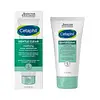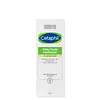What's inside
What's inside
 Key Ingredients
Key Ingredients

 Benefits
Benefits

 Concerns
Concerns

 Ingredients Side-by-side
Ingredients Side-by-side

Water
Skin ConditioningButylene Glycol
HumectantDimethicone
EmollientCetearyl Alcohol
EmollientSodium Polyacrylate
AbsorbentGlycerin
HumectantCeteareth-20
CleansingEthylhexyl Palmitate
EmollientHydrogenated Polydecene
EmollientCetyl Alcohol
EmollientStearyl Alcohol
EmollientAluminum Starch Octenylsuccinate
AbsorbentPhenoxyethanol
PreservativePPG-2 Myristyl Ether Propionate
EmollientAlpha-Glucan Oligosaccharide
CleansingSalicylic Acid
MaskingPolysorbate 60
EmulsifyingSqualane
EmollientCaprylic/Capric Glycerides
EmollientCaprylyl Glycol
EmollientZinc Gluconate
Skin ConditioningC12-15 Alkyl Lactate
EmollientMorus Alba Root Extract
BleachingAllantoin
Skin ConditioningBisabolol
MaskingEthylhexylglycerin
Skin ConditioningHexylene Glycol
EmulsifyingSafflower Oil/Palm Oil Aminopropanediol Esters
Skin ConditioningSodium Hydroxide
BufferingPPG-5-Laureth-5
EmollientKojic Acid
AntioxidantDisodium EDTA
Hydroxypropyl Cyclodextrin
MaskingSophora Angustifolia Root Extract
Skin ConditioningArctostaphylos Uva Ursi Leaf Extract
Skin ConditioningGlycyrrhiza Glabra Root Extract
BleachingPolyquaternium-11
Scutellaria Baicalensis Root Extract
AstringentSodium Hyaluronate
HumectantWater, Butylene Glycol, Dimethicone, Cetearyl Alcohol, Sodium Polyacrylate, Glycerin, Ceteareth-20, Ethylhexyl Palmitate, Hydrogenated Polydecene, Cetyl Alcohol, Stearyl Alcohol, Aluminum Starch Octenylsuccinate, Phenoxyethanol, PPG-2 Myristyl Ether Propionate, Alpha-Glucan Oligosaccharide, Salicylic Acid, Polysorbate 60, Squalane, Caprylic/Capric Glycerides, Caprylyl Glycol, Zinc Gluconate, C12-15 Alkyl Lactate, Morus Alba Root Extract, Allantoin, Bisabolol, Ethylhexylglycerin, Hexylene Glycol, Safflower Oil/Palm Oil Aminopropanediol Esters, Sodium Hydroxide, PPG-5-Laureth-5, Kojic Acid, Disodium EDTA, Hydroxypropyl Cyclodextrin, Sophora Angustifolia Root Extract, Arctostaphylos Uva Ursi Leaf Extract, Glycyrrhiza Glabra Root Extract, Polyquaternium-11, Scutellaria Baicalensis Root Extract, Sodium Hyaluronate
Water
Skin ConditioningOctocrylene
UV AbsorberDiisopropyl Adipate
EmollientCyclopentasiloxane
EmollientGlycerin
HumectantButyl Methoxydibenzoylmethane
UV AbsorberGlyceryl Stearate
EmollientPEG-100 Stearate
Polymethyl Methacrylate
Phenoxyethanol
PreservativeBenzyl Alcohol
PerfumingTriethanolamine
BufferingAcrylates/C10-30 Alkyl Acrylate Crosspolymer
Emulsion StabilisingTocopheryl Acetate
AntioxidantCarbomer
Emulsion StabilisingDisodium EDTA
Water, Octocrylene, Diisopropyl Adipate, Cyclopentasiloxane, Glycerin, Butyl Methoxydibenzoylmethane, Glyceryl Stearate, PEG-100 Stearate, Polymethyl Methacrylate, Phenoxyethanol, Benzyl Alcohol, Triethanolamine, Acrylates/C10-30 Alkyl Acrylate Crosspolymer, Tocopheryl Acetate, Carbomer, Disodium EDTA
 Reviews
Reviews

Ingredients Explained
These ingredients are found in both products.
Ingredients higher up in an ingredient list are typically present in a larger amount.
Disodium EDTA plays a role in making products more stable by aiding other preservatives.
It is a chelating agent, meaning it neutralizes metal ions that may be found in a product.
Disodium EDTA is a salt of edetic acid and is found to be safe in cosmetic ingredients.
Learn more about Disodium EDTAGlycerin is already naturally found in your skin. It helps moisturize and protect your skin.
A study from 2016 found glycerin to be more effective as a humectant than AHAs and hyaluronic acid.
As a humectant, it helps the skin stay hydrated by pulling moisture to your skin. The low molecular weight of glycerin allows it to pull moisture into the deeper layers of your skin.
Hydrated skin improves your skin barrier; Your skin barrier helps protect against irritants and bacteria.
Glycerin has also been found to have antimicrobial and antiviral properties. Due to these properties, glycerin is often used in wound and burn treatments.
In cosmetics, glycerin is usually derived from plants such as soybean or palm. However, it can also be sourced from animals, such as tallow or animal fat.
This ingredient is organic, colorless, odorless, and non-toxic.
Glycerin is the name for this ingredient in American English. British English uses Glycerol/Glycerine.
Learn more about GlycerinPhenoxyethanol is a preservative that has germicide, antimicrobial, and aromatic properties. Studies show that phenoxyethanol can prevent microbial growth. By itself, it has a scent that is similar to that of a rose.
It's often used in formulations along with Caprylyl Glycol to preserve the shelf life of products.
Water. It's the most common cosmetic ingredient of all. You'll usually see it at the top of ingredient lists, meaning that it makes up the largest part of the product.
So why is it so popular? Water most often acts as a solvent - this means that it helps dissolve other ingredients into the formulation.
You'll also recognize water as that liquid we all need to stay alive. If you see this, drink a glass of water. Stay hydrated!
Learn more about Water